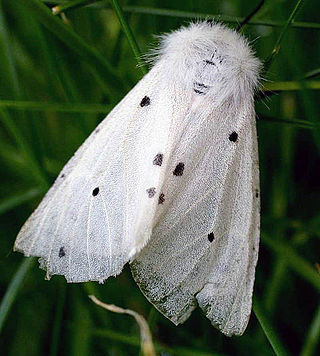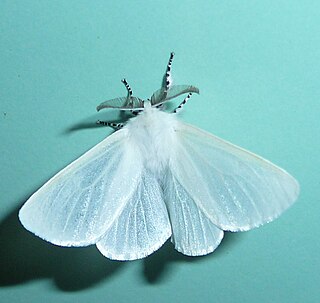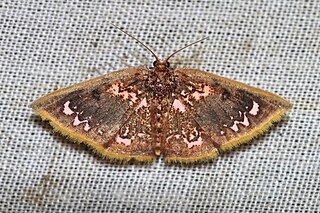
The silver-washed fritillary is a common and variable butterfly found over much of the Palearctic realm – Algeria, Europe and across the Palearctic to Japan.

Ornithoptera alexandrae, the Queen Alexandra's birdwing, is the largest species of butterfly in the world, with females reaching wingspans slightly in excess of 25 cm to 28 cm. This birdwing is restricted to the forests of the Oro Province in eastern Papua New Guinea.

Lampides boeticus, the pea blue, or long-tailed blue, is a small butterfly that belongs to the lycaenids or gossamer-winged family.

The silver Y is a migratory moth of the family Noctuidae which is named for the silvery Y-shaped mark on each of its forewings.

b

Hippotion celerio, the vine hawk-moth or silver-striped hawk-moth, is a moth of the family Sphingidae. It was described by Carl Linnaeus in his 1758 10th edition of Systema Naturae.

Diaphora mendica, the muslin moth, is a moth of the family Erebidae. It is found in the Palearctic realm east to Lake Baikal.

Polyommatus amandus, the Amanda's blue, is a butterfly of the family Lycaenidae. It is found in the Palearctic realm.

Leucoma salicis, the white satin moth or satin moth, is a moth of the family Erebidae. The species was first described by Carl Linnaeus in his 1758 10th edition of Systema Naturae. It is found in Europe including the British Isles but not the far north. In the east it is found across the Palearctic to Japan. Also in North America where it was introduced in the 1920s.

Discophlebia catocalina, the yellow-tailed stub moth is an Australian moth species found in the south-eastern quartile of Australia. It is classified within the Oenosandridae moth family in the Noctuoidea Superfamily, the largest superfamily of the Order Lepidoptera. It is visually recognised by its characteristic pointed yellow tail and is a medium-sized moth species with a wingspan range of 40mm-60mm depending on gender. Discophlebia Catocalina have evolved to feed on various species of eucalypt.

Aporandria is a monotypic moth genus in the family Geometridae described by Warren in 1894. Its single species, Aporandria specularia, was first described by Achille Guenée in 1857. It is found in Sri Lanka, India, Vietnam, Thailand, the Andamans, Peninsular Malaysia, Sumatra, Borneo, the Philippines and Sulawesi.

Abantiades latipennis, known as the Pindi moth, is a species of moth in the family Hepialidae. It may also be referred to as a swift moth or a ghost moth, as this is a common name associated with Hepialidae. Endemic to Australia and identified in 1932, it is most populous in temperate rainforest where eucalypti are prevalent, as the larvae feed primarily on the roots of these trees. Females lay eggs during flight in a scattering fashion. The larvae live for over eighteen months underground, while adult moths survive for approximately one week, as they have no mouthparts with which to feed. The moths are preyed upon by a number of predators, including bats and owls. Brown in colour overall, males are paler and the identifying silver bars of the male's wings are more prominent than those of the female's, with dark margins. Male adults are generally smaller.
Clarkeophlebia is an enigmatic and almost-unknown gelechioid moth genus. It contains a single species, Clarkeophlebia argentea, and is apparently endemic to Fatu Hiva in the Marquesas Islands of Polynesia. It was originally described as Acanthophlebia, but this name had earlier been given to a genus of prong-gilled mayflies.

Thyas coronata is a species of moth of the family Erebidae first described by Johan Christian Fabricius in 1775. It is found from the Indo-Australian tropics of southern China, Taiwan, Japan, Nepal, India, Sri Lanka to Micronesia and the Society Islands.

Chlorostrymon simaethis, the silver-banded hairstreak, is a North and South American butterfly in the family Lycaenidae. It is also known as St. Christopher's hairstreak and the Key lime hairstreak.

Epione vespertaria, the dark bordered beauty, is a moth of the family Geometridae.

Junonia iphita, the chocolate pansy or chocolate soldier, is a butterfly found in Asia.

Ichneutica arotis is a moth of the family Noctuidae. It is endemic to New Zealand. This species is found throughout the North and South Islands but has yet to be recorded on Stewart Island. I. arotis is variable in appearance and have been described as having a "northern dark form", a "typical" form and a "swamp" form. Robert Hoare hypothesised that this species may be in the process of evolving into several distinct species. However, as these forms show no difference in antennae or genitalia so, as at 2019, they are not regarded as separate species. Larval hosts include species in the genera Cortaderia and Schoenus as well as Phormium tenax. The caterpillar feeds at night and rests in during the day amongst dead flax leaves. It pupates in a loose cocoon either hidden at the base of a stem of flax or on the ground. The adults of this species is on the wing from September to April. In the North Island there have also been records of adults being on the wing in June to August.

Chrysocraspeda abhadraca is a species of moth in the family Geometridae described by Francis Walker in 1861. It is found in Indian subregion including India and Sri Lanka, Peninsular Malaysia, Sumatra and Borneo.

Hamadryas iphthime, the ringless blue cracker or brownish cracker, is a species of cracker butterfly in the family Nymphalidae. It was first described by Henry Walter Bates in 1864. It is found in Mexico, Central America and parts of northern South America.





















